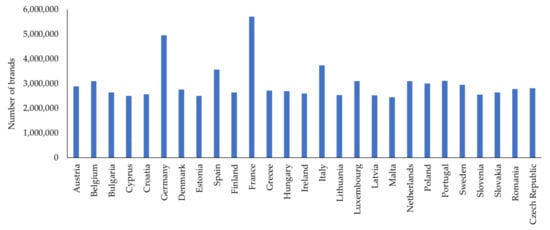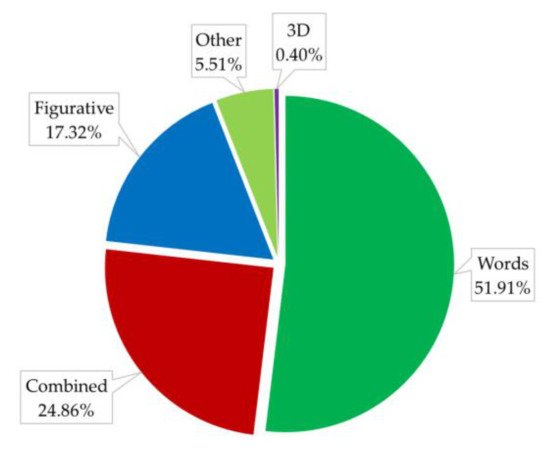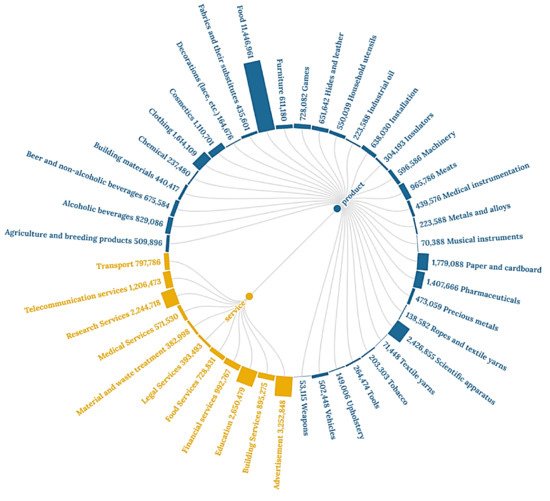Your browser does not fully support modern features. Please upgrade for a smoother experience.
Please note this is an old version of this entry, which may differ significantly from the current revision.
Subjects:
Environmental Sciences
Trademarks are distinctive signs designed to promote and enhance the products/services of companies. In recent years, the concept of quality has asserted growing interest, especially among enterprises, aiming to promote consumers by creating distinctive marks.
- quality trademarks
- standardization
- historical trademarks
1. Introduction
Customers’ choice of goods and services is often influenced by visual recognition and the memory of trademarks [1]. They are an essential part of everyday life as they shape people’s choices and attitudes and predispose them to consumption [2,3]. According to Regulation (EU) 2017/1001 [4], trademarks represent all those signs such as words, names of persons, designs, letters, numerals, colors, packaging and sounds, which are suitable to distinguish the goods or services of a company from those of other enterprises, and they could be considered as a tool for guaranteeing and recognizing the quality of a company, alternative but potentially complementary to certification [5]. They allow consumers to differentiate the products/services from others on the market, and they are placed at the base of the communication strategies of companies for the choice of products by consumers.
According to Reg. 2017/1001, the trademark should:
- −
-
Have distinctive skills: it cannot be limited to words that clarify only the type of activity carried out or product;
- −
-
Be lawful: it cannot be contrary to public order and must not violate the provisions of the law.
- −
-
Different trademark protection systems can be distinguished:
- −
-
International trademarks, administered by the World Intellectual Property Organization (WIPO), confer protection in different countries through the Madrid Convention and its Additional Protocol [6];
- −
-
European Union trademarks, which have general effect in all EU Countries, which do not replace national trademark systems but constitute a parallel and additional legal framework in the territory of the EU Member States [7];
- −
-
National trademarks, registered by the Intellectual Property Offices of the Member States (Ufficio Italiano Brevetti e Marchi—UIBM, for Italy) based on a harmonized system at EU level [7].
In recent years, brands are no longer considered only as marketing tools but also as means that allow achieving relevant social results, such as promoting healthy life, sustainable behaviors for the environment, ethically correct choices aimed at safeguarding workers, and more. Therefore, brands play a vital role for the consumer, representing the possibility of creating a bond of relationship and trust, through repeated consumption, between the consumer and the company that owns the brand [3]. Indeed, this link between the consumer and brand can influence the company performance holding the brand [2,3,4]. In this regard, it is essential to highlight how the “customer experience” is one of the main factors in strong brands development (brands that have strong originality and a remarkable distinctive capacity) and how brand coverage from a media point of view can influence individual choices and preferences [8].
In this regard, the concept of “brand equity” was born, that is, the added value that a particular brand gives to the products/services of a company [9]. Therefore, the representation of goods/services through brands acts as a differential element that helps the consumer’s decision-making based on personal experiences. Therefore, all those brands that present and confer high brand equity can allow for better profit margins, consequently improving communication with the consumer and therefore playing a significant role in the consumer’s choices and increasing the credibility of the company associated with that brand [10]. Furthermore, brands with high brand equity can present improved future profits, induce customers to pay higher prices, and increase brand visibility in the market. Therefore, brands are strategically important because they allow companies to communicate their value to the consumer and become a benchmark within their industry. It is possible to distinguish between quality marks (QMs) and historical marks (HMs) in this context. The former is used to certify the value of raw materials and production and processing methods of certain products [11].
The importance of QMs refers to the protection of the consumer, who is more aware of the product’s characteristics, and the producer, who sees his work recognized through an official certification. In contrast, the latter is used to recognize the protection of products or services made by a productive national enterprise of excellence historically linked to a specific territory [12]. In this way, products acquire added value compared to conventional ones, entering a different market niche characterized by quality and higher prices. The strategic importance of HMs concerns being a lever for a country’s competitiveness and internationalization.
2. Trademarks in Europe
The Treaty on the Functioning of the European Union [13] provides that in order to establish and operate the internal market, standard measures shall be established among the 27 Member States of the European Union in order to ensure uniform protection of intellectual property rights in the Union and for the setting up of centralized authorization, coordination and control systems at Union level. Regulation (EU) 2424/2015 [14], repealing Council Regulation (EC) 207/2009 [15], created a specific trademark protection system for the European Union, which operates in parallel with the trademark protection available at the level of individual member states following their respective national protection systems.
Regulation (EU) 2424/2015 provides the following definition of a European Union trademark: “all signs, such as words, including names of persons or designs, letters, numerals, colors, the shape of goods or their packaging, and sounds, provided that such signs are suitable for: (i) distinguish the goods or services of one undertaking from those of other undertakings; (ii) be represented in the EU register of trademarks in such a way as to enable the competent authorities and the public to determine clearly and precisely the subject matter of the protection granted to their proprietor” (Art. 4 reg. 2424/2015).
Regulation (EU) 2424/2015 and Directive (EU) 2015/2436 [16] constitute the “trademark package”. These are the two parts of reference legislation aimed at harmonizing the Member States’ trademark laws with each other, but also to make the national laws and that part of European regulation that directly controls the “European Union trademark”, that is, the industrial property title issued by the European Intellectual Property Office (EUIPO) that is in effect in all Member States.
In Europe, the number of trademarks registered in 2021 was approximately 15 million [17]. The countries with the highest number of brands are France (5.7 million), followed by Germany (4.9), Italy (3.7) and Spain (3.5) (Figure 1) [18]. Of these, 51.91% are words, while the remainder are combination marks (words/figure) (24.86%), figures (17.32%) and others (5.51%) (Figure 2) [18].

Figure 1. Number of the brand in 27 Member Countries of the EU [18].

Figure 2. Different types of trademarks in the EU [18].
Figure 3 [18] shows the trademarks registered in the EU divided according to the Nice Classification [19], which divides them into product and service marks. Product trademarks are in turn subdivided into 34 classes according to the nature of the product in question, and service marks are subdivided into 11 subclasses, thus making it possible to classify directly or by analogy most products and services.

Figure 3. Number of produce and service brands in Europe in 2021 [18].
The most widely registered product brands are in the agri-food sector (11.5 million), scientific instruments (2.5 million), paper and cardboard (1.7 million), clothing (1.6 million), pharmaceuticals (1.4 million) and cosmetics (1.1 million). As far as service brands are concerned, those in the training sector (2.6 million), advertising (3.2 million) and scientific research (2.2 million) are those most represented. Of these brands, only 52.09% are registered, the remaining percentage being represented by 34.04% of expired brands, 10.36% of ended brands and 2.7% of filled brands [18].
2.1. Quality Marks in the EU
QMs, compared to individual and collective marks, whose differences are expressed in Table 1, are different not only in terms of function but also in some more formal aspects. EU quality policy aims to protect the names of specific products in promoting their unique characteristics related to geographical origin and traditional skills. Therefore, QMs are tools for recognizing the added value of a specific product in terms of its origin and-or production methods, generally linked to a local tradition or territoriality [20,21]. In the EU, QMs have been defined in the first instance by Directive 2006/123/EC [22] as those marks whose function is to certify whether the product/service on which the brand is affixed has specific quality characteristics and/or follows certain ethical, environmental, etc. standards. Therefore, this brand indicates that the good or service has achieved specific quality standards set by the certifying body.
Table 1. Differences between individual, collective and certification marks.
| Individual Brand | Collective Brand | Certification Brand |
|---|---|---|
| It has the function of distinguishing the production or marketing of products and services by bringing them back to one entrepreneur rather than another. | It indicates that the protected goods or services come from members of an association and can only be used by the latter. | It is an indication that the goods or services meet specific characteristics (e.g., qualities) defined in the regulations of use. |
| A natural person or a company can register it. It will also be that person or company to use the trademark and have exclusive rights. | Only associations of manufacturers, producers, service providers or traders, and legal persons under public law (if they have an organization like that of associations) may file a collective mark application. | The holder of a certification mark may not manage an activity involving the supply of goods and services of the certified type (neutrality requirement). |
| It cannot describe a product’s characteristics or indicate its geographical origin because it is information about the product that a single company cannot monopolize. | The application must include the rules of use. | Natural persons may also apply for a certification mark. |
| - | - | The application must include the rules of use. |
A QM refers to the assurance of specific characteristics of certain products and services. One crucial difference is that the holder of a certification mark (a natural or legal person, an institution or authority, and bodies governed by public law) may not operate an activity involving providing products and services of the certified type [23]. The holder of a QM may certify the products and services that others use in their respective activities but may not certify his products and services and use certification himself. He has an obligation of neutrality about the interests of the manufacturers of the products or providers of the services he certifies [24]. A quality mark can be defined by four aspects [25]:
- −
-
It must be a sign likely to be represented in the EU trademark register. In addition, such a sign should distinguish goods and services that are certified from others that are not.
- −
-
When submitting a QM application, the type of mark for which the application is made should be indicated very clearly.
- −
-
The QM application must relate to the goods and services certified by the trademark owner.
- −
-
It must include the regulations for using the QM for which the application is made.
The use regulation constitutes the essence of the QM. Table 2 shows the mandatory contents that QM “regulations use” must have (17 of Implementing Regulation (EU) 2018/626) [26]. The EU Regulations define that QMs must be filed within two months of application and contain:
Table 2. Mandatory information to be reported in the regulation of the use of quality marks in the EU [20,26].
| Mandatory Information | Description |
|---|---|
| Name of the applicant | The applicant’s name must be the same as that in the application for the trademark registration |
| The declaration that the applicant does not carry out any activity involving the supply of products or services that must be certified with the QM. | The following particulars shall be given: “I hereby declare that I am not carrying out any activity involving the supply of [products] [services] [products and services] subject to certification”. “[Name of applicant] declares that it fulfils the conditions laid down in Article 83(2) of Regulation (EU) 2017/1001 of the European Parliament and of the Council of June 14 2017, on the European Union trademark.” |
| Representation of QM | The representation of the mark must be the same as that shown in the application. |
| The products or services covered by the QM. | The list of goods and/or services is the same as that provided in the application, referring to the EU community application number. |
| The characteristics of the products or services to be QM certified (like the material, the manufacturing process of the products or the provision of services, quality or precision). | The description of the characteristics of the applicant is certifying can be provided using general terms, without indicating in detail all aspects and all technical specifications. The characteristics must be specified and explained clearly, being necessary to allow the target public to understand them clearly and precisely:
|
| The conditions of use of the EU certification mark, including penalties. |
|
| Persons authorized to use the QM. |
|
| The procedures for verifying the characteristics and monitoring the use of the QMs by the certification body. |
|
- ▪
-
The declaration that the applicant is not carrying out any activity involving the certified type’s supply of products or services.
- ▪
-
The characteristics of the products or services to be certified.
- ▪
-
The conditions of use of the EU certification mark.
- ▪
-
The holder of the MFF applies the verification and monitoring arrangements.
This entry is adapted from the peer-reviewed paper 10.3390/standards2020009
This entry is offline, you can click here to edit this entry!
